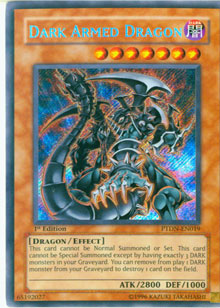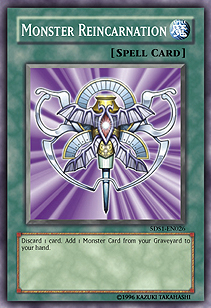 At the moment it’s pretty clear what the two best monsters in the game are. Dark Armed Dragon and Judgment Dragon each provide an unparalleled dimension of destruction and reliability to their respective archetypes. The ability to destroy all cards on the field with little to no cost is incredible, and the two Dragons can do just that. Of course, each requires you to be playing a specific archetype.
At the moment it’s pretty clear what the two best monsters in the game are. Dark Armed Dragon and Judgment Dragon each provide an unparalleled dimension of destruction and reliability to their respective archetypes. The ability to destroy all cards on the field with little to no cost is incredible, and the two Dragons can do just that. Of course, each requires you to be playing a specific archetype.
Having three Darks in your graveyard at the same time you have Dark Armed Dragon in hand isn’t as easy as it sounds, and it takes the speed of Teleport Dark Armed Dragon to produce the scenario reliably and quickly. On the other hand, getting four different Lightsworn monsters in your graveyard means you not only have to be playing a lot of different Lightsworn monsters, you have to be playing them in multiples. That’s a lot of devotion to monsters that are only necessary to play two Dragons. Factor in the support necessary to make the strategy consistent and you can see why most people don’t think Twilight can work.
In the eyes of most people, the deck tries to do too much. Dropping both Dark Armed Dragon and Judgment Dragon at the same time requires such a lucky series of events that you’ll rarely get the perfect game-ending scenario Twilight decks always dream of. Still that’s what most people aim to achieve, and the result has been inconsistent performances and a 6–3 finish at best.
But I’ve been playing around with Twilight myself recently, and what I’ve found is that if you play it as a control deck you’ll find much better results. You may not ever drop both Dragons together, but if you can play Dark Armed Dragon one turn and follow it up next turn with Judgment Dragon your opponent is going to be in a tough spot. That’s two turns of field-clearing cards and an easy 5800 damage. You only need to deal 2200 more to win the game, and Lumina, Lightsworn Summoner can produce just that.
With that in mind let’s take a look at Erin Diaz’s deck from Shonen Jump Championship Chicago:
Monsters: 23
2 Judgment Dragon
1 Dark Armed Dragon
1 Phantom of Chaos
3 Lumina, Lightsworn Summoner
 2 Garoth, Lightsworn Warrior
2 Garoth, Lightsworn Warrior
3 Lyla, Lightsworn Sorceress
1 Jain, Lightsworn Paladin
2 Ehren, Lightsworn Monk
3 Necro Gardna
1 Wulf, Lightsworn Beast
1 Ryko, Lightsworn Hunter
1 Celestia, Lightsworn Angel
1 Honest
1 Breaker the Magical Warrior
Spells: 16
3 Solar Recharge
1 Card Destruction
1 Allure of Darkness
1 Monster Reborn
1 Heavy Storm
1 Cold Wave
3 Monster Reincarnation
2 Reinforcement of the Army
3 Charge of the Light Brigade
Traps: 1
1 Beckoning Light
This is a seriously good Twilight build, largely because Erin has cut a lot of the inconsistencies most players are reluctant to let go of. Wulf, Lightsworn Beast used to cause a lot of problems: back when 1800 ATK was the limit and anything that high or above meant the use of Test Tiger, sending a copy of Wulf to your graveyard and summoning it could help protect bigger monsters down the road. But these days Wulf just gets trampled by Colossal Fighter or Goyo Guardian. The chances of drawing it are often as good as sending it to the graveyard, so why take the risk when the payoff isn’t even that great?
 Diaz plays only one copy of Wulf, showing tremendous restraint. Now Wulf is almost a power card, coming out randomly and simply adding to Diaz’s plans. He’ll never hope to special summon Wulf during the end phase, so when it happens it’ll just add to whatever his plan already was. Plus it’s another different Lightsworn monster in the graveyard and Erin plays enough discard effects to offset the negative impact if a single Wulf is drawn.
Diaz plays only one copy of Wulf, showing tremendous restraint. Now Wulf is almost a power card, coming out randomly and simply adding to Diaz’s plans. He’ll never hope to special summon Wulf during the end phase, so when it happens it’ll just add to whatever his plan already was. Plus it’s another different Lightsworn monster in the graveyard and Erin plays enough discard effects to offset the negative impact if a single Wulf is drawn.
What Erin wants to do is make sure the effects of Judgment Dragon or Dark Armed Dragon go off, and that he can swarm the field with Lumina, Lightsworn Summoner. That’s why he plays three copies of her in addition to three copies of Charge of the Light Brigade. The optimal target for Lumina is Garoth, Lightsworn Warrior. Reinforcement of the Army is played here as well, to help make sure Garoth can be summoned. This deck can make Lumina + Garoth the same way that TeleDAD can achieve Elemental Hero Stratos + Dark Grepher. The two make quite a good end-phase combo, sending five cards to the graveyard (ten if you have a second Lumina) and allowing for a potential two (or four) draws with Garoth’s ability.
You’ll notice that Diaz only plays one copy of Dark Armed Dragon in his main deck—he side decks the second. That’s because Dark Armed isn’t the primary strategy. Rather, it’s something that can either be drawn or sent to the graveyard during the end phase to be recovered later. Erin plays a total of six Dark monsters, three of which can remove themselves from play. That offers him great control over his graveyard. He can allow it to fill up as much as he desires because it can be dropped to the necessary amount at any time.
Of course having Dark Armed Dragon in your hand is necessary as well, and that’s why Diaz plays three copies of Monster Reincarnation. I believe playing three of these was the reason for Diaz’s success at this tournament, and if I were to ever play Twilight it would definitely include three copies of this card. Reincarnation can grab Dark Armed Dragon once it’s been sent to the graveyard at any point during the duel thanks to a Lightsworn effect. It can also get back Judgment Dragon. That’s enough reason to play it on its own, since these cards are sent to the graveyard so often that Reincarnation will almost always be live.
 But if you happen to draw one of the Dragons already, Reincarnation is still a huge card. When you successfully summon Judgment Dragon but it gets destroyed (or the summon itself is negated), there’s still enough Lightsworn in your graveyard to special summon another one. Monster Reincarnation can just let you pick up the destroyed Dragon and reuse it once more. The same can be said for Dark Armed Dragon. Almost every time Dark Armed is stopped, it’s shut down with Solemn Judgment. The result is four Darks in the graveyard and nothing on the field destroyed. Monster Reincarnation takes the Dark Armed back and puts your graveyard back to three Darks total at the same time.
But if you happen to draw one of the Dragons already, Reincarnation is still a huge card. When you successfully summon Judgment Dragon but it gets destroyed (or the summon itself is negated), there’s still enough Lightsworn in your graveyard to special summon another one. Monster Reincarnation can just let you pick up the destroyed Dragon and reuse it once more. The same can be said for Dark Armed Dragon. Almost every time Dark Armed is stopped, it’s shut down with Solemn Judgment. The result is four Darks in the graveyard and nothing on the field destroyed. Monster Reincarnation takes the Dark Armed back and puts your graveyard back to three Darks total at the same time.
There’s also the fact that Solemn Judgment costs life points. If your opponent uses Solemn to save him- or herself from destruction via Judgment Dragon, it usually means he or she will lose if you have a second copy. Having three copies of Monster Reincarnation to back up the second Judgment Dragon quadruples your outs to win the game. Beckoning Light does too, actually, so you pretty much have five times the outs.
Phantom of Chaos is a great card for breaking game positions with multiple copies of Solemn Judgment. Having Judgment Dragon and Monster Reincarnation is great, but if your opponent has multiple copies of Solemn you still lose out. However, if you force your opponent to activate the first on Judgment Dragon, then summon Phantom of Chaos, your opponent is going to have to Solemn the Phantom unless that player is willing to lose his or her whole field. That leaves you free to use your second Judgment without worry.
All the spell and trap destruction effects help Diaz achieve the same end. The idea is to play either Dragon safely, and for it to do big damage. That damage is amplified when another Dragon comes down next turn, and ideally you’ll either win with that one or have a third ready to go. Cards like Solemn Judgment, Torrential Tribute, and Bottomless Trap Hole effectively reduce the number of Dragons you play because their impact is totally negated. Take care of these cards and your Dragons are for real. You become the aggressor, and with two Dragons you’ll likely win the game.
—Matt Peddle